 |
The Saint of the Day
St. Athanasius - May 2
Prof. Plinio Corrêa de Oliveira
I just finished reading a synopsis of the life of St. Athanasius (c. 296-373), who was one of the greatest saints of the Church. Some aspects of his life that I did not know caught my attention, and they seemed appropriate to address with you today.
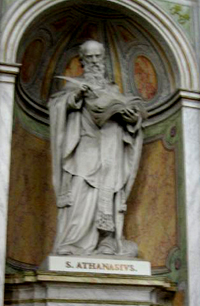
St. Athanasius
|
You know that St. Athanasius lived at the time of the Emperor Constantine and his immediate successors. That is, in an epoch when the Church was leaving the catacombs and organizing herself in the light of day. As the persecutions promoted by the pagans declined, the Church suffered another scourge, certainly worse than the pagan persecutions: the scourge of heresies and internal divisions, which we know very well since we are witnessing now something similar with Progressivism inside the Church.
One of the most nefarious heresies of History expanded precisely at the time of St. Athanasius and Constantine: it was the heresy of Arianism. The followers of Arius affirmed that Our Lord Jesus Christ had only a human nature, and was not God. They admitted that He was an extraordinary man, but not God. This heresy, as you can see, implied the negation of the entire Catholic Religion, because to reduce Our Lord to a mere man is to deny almost all the dogmas of the Catholic Church.
The Arians were very powerful. They quickly spread from the Mediterranean Basin and, by means of intrigues and defamations at which they excelled, they attained considerable influence in the imperial court and dragged an enormous number of the faithful, priests and Bishops along with them. Some time later, St. Jerome, commenting on how fast that heresy had spread, declared that one day the whole world woke up and realized that it had become Arian. The heresy conquered everything, everywhere, with lightning speed.
In the fight against Arianism, the great giant was St. Athanasius. He was the Patriarch Archbishop of Alexandria, one of the most important episcopal sees of the time. Because of the Arian plots against him, he was obliged to flee the city five times, spending 17 of the 46 years of his episcopate in exile. Some of these exiles were caused by imperial decrees against him, due to Arian intrigues in the court. He was not only persecuted, but also threatened with death in that tremendous fight in which he was involved. Some episodes of this fight are not well-known.
We know about his doctrinal quarrel with the Arians. We know less about some of the hunt and chase episodes in his battle against them. In the life of this great saint, even small anecdotes are worthwhile to know so that we might realize how much the position of resistance against heresy demands.
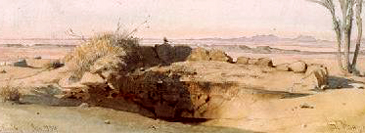
A well in a desert of Egypt
|
In one of his flights, he was obliged to spend six years hidden at the bottom of an abandoned well. One faithful Catholic passed by it each day and supplied what he needed for his bare sustenance. I am not sure whether you realize what this signifies. He could not leave the well during daylight. He had to remain imprisoned in a very small area for a long period of time. He certainly was praying and meditating on the glory of God, so that during those six years God received from the depths of that well a perfect worship. He was always confident in Divine Providence, always disposed to fight, always unwavering in his orthodox purposes. His friend informed him when the persecution diminished, and he left the well, returning to his combat against Arianism.
Another time the trial was less difficult, but also impressive. He had to flee through the deserts of Egypt and the only secure place he could find to hide was his father’s grave. He spent four months there. It is ghoulish. The sensibility of any man is horrified at this perspective. He was a great saint, he conquered this repugnance. To evaluate his suffering we must consider the self-mastery this signified. At the end of those four months, he returned to the battle.
His principal combat against Arianism was made through his sermons; his words were taken down, copied and spread throughout the Roman Empire.
On another occasion he was summoned to appear before a council of Arian bishops in the city of Tyre. He declared he would not go because the bishops were heretics. He did not recognize those heretics as Catholics and desired no communion with them. However, he received an order from the Emperor in the form of a decree obliging him to go and defend himself against the accusations of the heretics. He was forced to go, not because he accepted that assembly as legitimate, but because the imperial authority obliged him. So, he went and he fought against that pseudo-council, that gathering of heretics.
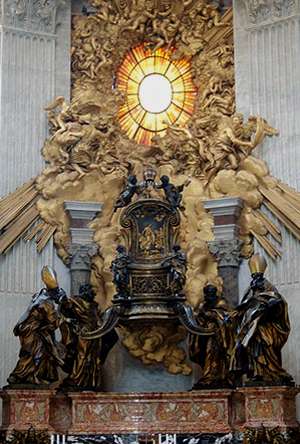
To the right of the Bernini's famous Chair of St. Peter are St. Ambrose and St. Augustine, to the left are St. Athanasius and St. John Chrysostom
|
More than 100 bishops were present, which then was a large number. At that time religious councils took place with a grand ceremonial air, even among the heretics. When he entered the hall followed by a faithful priest, the bishops were all seated in their solemn vestments. He remained standing in the center of the room, and no one offered him a chair. The discussion began. Soon he noticed that the heretics did not want to discuss doctrine, which is common for all heretics. They normally launch personal attacks and slanders.
At that meeting, different calumnies were made against the Saint and a clamorous hatred rose up against him. When silence was established, a prostitute was brought forward as a witness, who told the assembly that she had become wealthy thanks to the payments of St. Athanasius for her infamous services. She also affirmed that she was with him during his long absences from Alexandria, and had witnessed all kinds of sexual depravations he committed. As she spoke those lies, the Arians bishops began to demand even louder that he be deposed and imprisoned. Here we can see how at times heretics pretend to be zealous for good customs in order to persecute true Catholics.
Facing that raucous storm of accusations, St. Athanasius, giving proof of his high intelligence, said nothing. He remained serene and let those around him to continue shouting. He whispered something in the ear of the priest who accompanied him, and the latter drew near the prostitute. When she paused in her vilifications, the priest addressed her in a loud voice, pretending that he was St. Athanasius: “Are you sure that you were really with me on this and that occasion, and that I did this and that?”
The woman, who obviously knew neither the priest nor St. Athanasius, fell into the trap and answered: “Yes, I am sure that you did this with me, and I am sure that it was you, Athanasius.” “Do you swear it?” “Yes, I swear it!”
The imposture of that woman became so flagrant that the assembly reacted as all of you did – it broke out into laughter. Those accusations became so ridiculous that the majority of the bishops wanted to disperse the council. But some of the more fanatical heretics convinced the others to stay and listen to more charges against St. Athanasius. We can see how far the bad faith of those heretics went. Don’t think that this was an isolated occasion in the past: the progressivists today have the same bad faith against true Catholics.
Any honest man would realize that after the credibility of the accusers had been destroyed by the prostitute’s lies, whatever more the bishops might say would be unreliable. But, since they were not honest men but heretics, they continued.
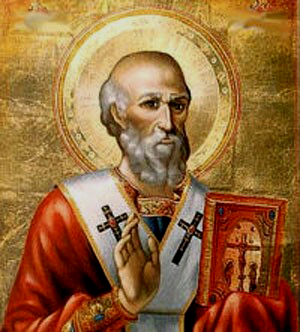
His principal fight against the heretics was made through his sermons and writings
|
One of the Arian bishops stood up, took a shriveled hand of a dead man from a box he was carrying, and told the assembly: “Here is the hand of the Meletian bishop X (Meletianism was another heresy with parallels to Arianism). He was murdered by Athanasius, who sought him out in the desert and killed him.” The desert was the one where St. Athanasius had hidden.
Again St. Athanasius remained serene and noticed a bishop in the assembly sitting in a secondary place with his face hidden. Then, he recognized that man – something only possible with divine assistance. He walked to a spot near that bishop and asked the accuser: “So, you say that bishop X is dead?”
“He is,” was the reply.
Then, St. Athanasius pulled off the hood covering the head of that man near him and said: “Here is bishop X, perfectly alive.”
He turned to the assembly and addressed them: “God has given us but two hands. Could you please ask bishop X to show us his hands?”
The bishop complied, showing his two hands.
Then, St. Athanasius told the assembly: “Now, since he has his two hands, you must decide where on his body you would like to place his third hand…” It was a second brilliant victory.
Do you think that this stopped the heretics? No, they continued with their defamations of St. Athanasius. Notwithstanding, the council became so demoralized that it was closed.
Another time, imperial troops crossed the path of St. Athanasius walking in the desert. The commander asked him: “Do you know Athanasius?”
He answered: “Yes, I do.”
The commander: “Do you know where he is?”
The Saint: “Yes, he is not far from here.”
As the troops began to search the area, he hid himself. St. Athanasius, who was a saint, a great doctor of the Church, had a horror of the lie. In this case, he did not lie; what he did was to not tell the whole truth, which anyone is entitled to do in his legitimate defense. He told a half-truth that saved him from imprisonment. Again, the incident shows his agility and great presence of mind, illustrating the richness of his personality.
Constantine the Great, the same emperor who had liberated the Church with his Edict of Milan in 313, later in his life became entangled in the Arian intrigues. Contrary to his former support, he took a position against St. Athanasius and exiled him to Gaul. St. Athanasius told him: “You forbid me to return to my patriarchal throne and support a heretic. Shortly you will give an account of this to God.”
He went to Gaul, remained there for a while, and then traveled to Rome to justify himself before the Pope, who gave him his full support. News of Constantine’s death soon reached him.
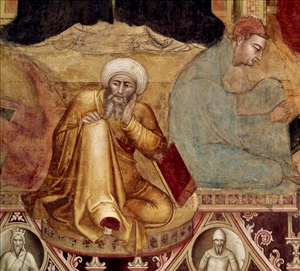
In a detail from The Triumph of St. Thomas Aquinas, Averroes and Arius, at right, sit vanquished at his feet
|
Before he died, Constantine had named Arius as patriarch of Constantinople. A grand solemn procession was organized for the inauguration ceremony. As Arius paraded proudly through the midst of the city, he was suddenly seized by stomach pain, accompanied by a violent relaxation of the bowels. He stopped the parade and retired to a convenient place behind Constantine’s Forum. Arriving there, his bowels protruded, followed by a copious hemorrhage and his intestines fell to the floor. It is said that this same thing happened to Judas the traitor while he was hanging from the fig tree. Arius died, and Constantine died soon afterward. He went to stand before God to give an account of his last actions, as St. Athanasius had predicted.
With his principal enemy Arius and the one who protected him both dead, St. Athanasius returned to Alexandria. His life would not be tranquil, however. New persecutions would start and continue throughout almost his whole life. The people of Alexandria loved him, but the rotten ecclesiastical leaders hated him. He was very well received by the people, so well received that an expression became proverbial: “To be welcomed like Athanasius.” The putrid ecclesiastical heads, however, never stopped spreading calumnies and defamations against him. Shortly after his return to Alexandria, almost all the bishops apostatized and embraced semi-Arianism, and fidelity to the Church was maintained by the simple people. That reception of St. Athanasius was symptomatic of the spiritual health of both the cupola and the grassroots.
These anecdotes from the life of St. Athanasius should encourage us to resist all kinds of heresies that make up part of the great heresy of Progressivism. Arianism in many ways was a prefigure of Progressivism, just as our fight is a post-figure of the fight led by St. Athanasius. The fidelity of the simple people when most of the bishops went astray should reinforce our conviction to continue defending the same orthodoxy the Church always taught. This similarity of vocation should lead us to have a special devotion to St. Athanasius and ask him to help us, protect us and enlighten us in the fulfillment of our anti-Progressivist mission.


  | | Prof. Plinio Corrêa de Oliveira | |
The Saint of the Day features highlights from the lives of saints based on comments made by the late Prof. Plinio Corrêa de Oliveira. Following the example of St. John Bosco who used to make similar talks for the boys of his College, each evening it was Prof. Plinio’s custom to make a short commentary on the lives of the next day’s saint in a meeting for youth in order to encourage them in the practice of virtue and love for the Catholic Church. TIA thought that its readers could profit from these valuable commentaries.
The texts of both the biographical data and the comments come from personal notes taken by Atila S. Guimarães from 1964 to 1995. Given the fact that the source is a personal notebook, it is possible that at times the biographic notes transcribed here will not rigorously follow the original text read by Prof. Plinio. The commentaries have also been adapted and translated for TIA’s site.
|
Saint of the Day | Home | Books | CDs | Search | Contact Us | Donate

© 2002- Tradition in Action, Inc. All Rights Reserved
|
 |

|